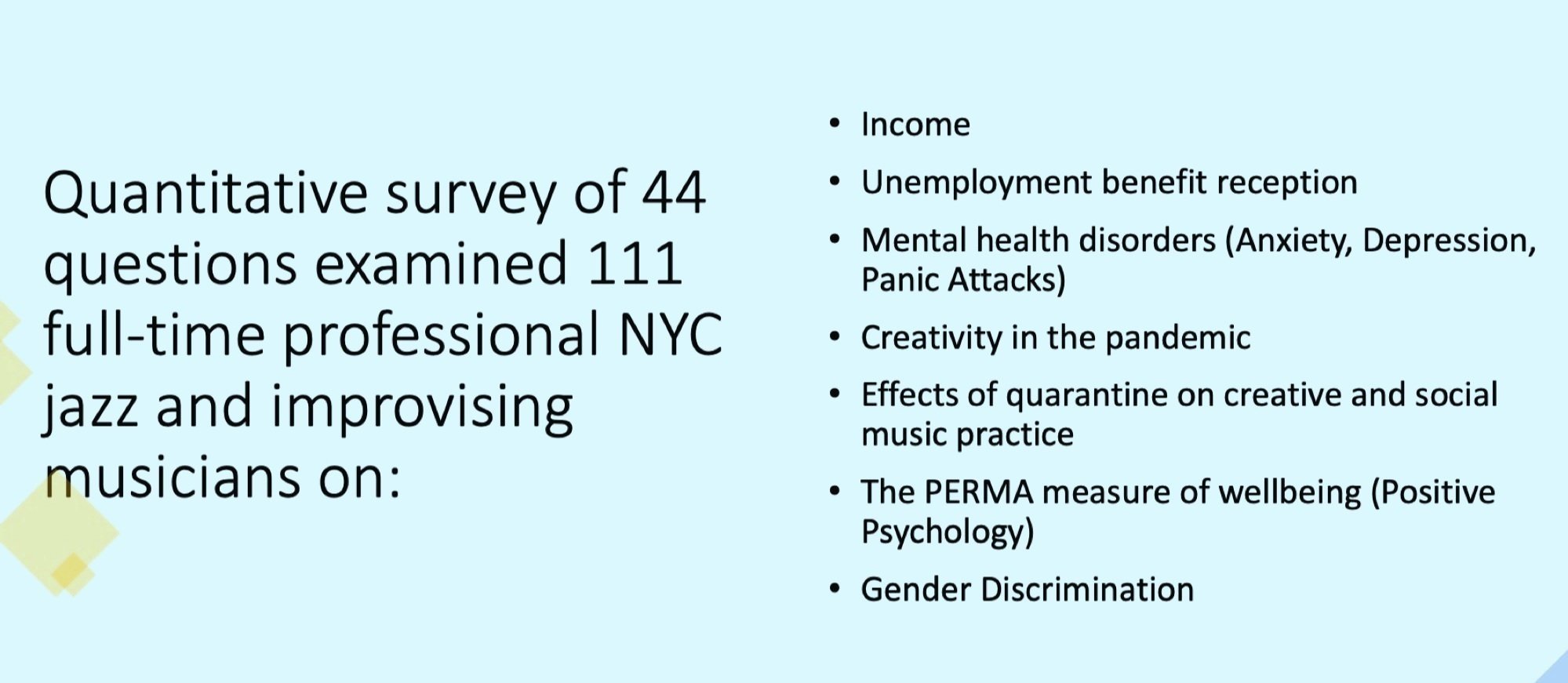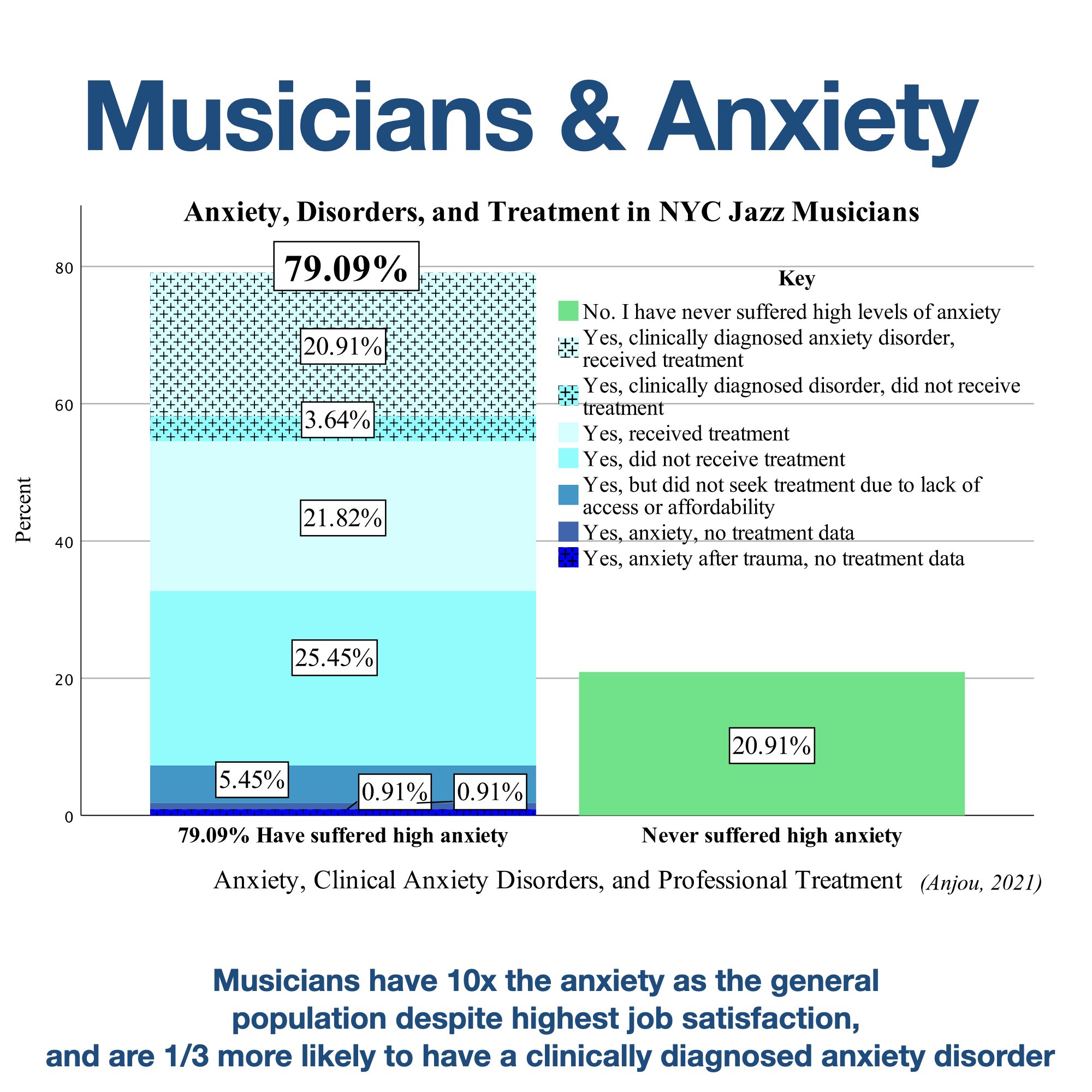RESEARCH ON THE MENTAL HEALTH
AND WELLBEING OF NYC JAZZ MUSICIANS
Slide from presentation at This Is A Movement (TIAM), 2022
No prior academic research had been conducted on the wellbeing and mental health of living musicians in the USA. I aimed to push psychology research forward by designing a mixed-methods study on professional musicians in New York City, to help the community and to understand and empathize with fellow musicians.
I designed and conducted a mixed-methods research project of NYC professional musicians’ mental health and wellbeing in Covid-19 in summer of 2021, surveying 111 full-time professional musicians on their income, mental health, and wellbeing. Here are some of the results from the basic questions from the quantitative study below. While I recruited and interview participants who identified as professional jazz and improvisationally trained musicians, a breakdown of the workforce by genre is included which indicates variations of employment and engagement in various working genres (requiring different approaches, subcultures, and various ethnographic and social music practices). Consider in fall and winter of 2021 musicians suffered additional repeated tour losses due to the Omicron virus and are vulnerable to tour cancellations in a post-pandemic world, as noted by NY Senator Brad Hoylman and the Music Workers’ Alliance at a press conference at the Village Vanguard on March 11th, 2022.
METHOD
My study was designed as a mixed-methods research project to fill gaps in the current literature on the health and wellbeing of musicians in the US, which obtained ethical approval from the University of Sheffield (UK) in spring 2021. For the quantitative research portion, a 44 question survey with 40 quantitative and 4 qualitative text entry questions was designed to fill gaps in current literature. The survey was revised and approved by music psychology scholars to reduce data redundancy and participant fatigue. NYC was chosen as the primary location to recruit participants due to its having a population of over 50,000 professional working musicians.
Once the survey was approved and optimized into a google link complete with an introductory info sheet about the project and obtaining ethical consent to participate, I distributed the survey via social media and email to over 5,000 musicians in New York City via the AFM Local 802 Musician’s Union, Music Worker’s Alliance, and Women in Jazz Organization, and my own social media network. The survey collected responses online from June until September 2021 until it reached 111 participants. I then analyzed the data using SPSS software to cross examine variables such as age, gender, income, and exported data to bar graphs.
Additionally, six qualitative interviews of professional musicians ranging from 11-48 years of work experience in New York were conducted remotely via Zoom, recorded, transcribed, and analyzed for themes with consent. I synthesize this information with the quantitative and qualitative survey results to draw conclusions and implications from the research.
QUANTITATIVE RESULTS
Here are partial relevant findings from my 2021 survey of 111 full-time professional NYC jazz and improvising musicians who participated in the survey. The participants surveyed were 72% white; 56% male, 36% female, 5% non-binary; and were an average age of 46 years old. Click here for an in-depth four part YouTube presentation hosted at my Music Psychology Salon, for results from all 40 quantitative questions in my comprehensive survey of musicians.
ANNUAL INCOME OF NYC MUSICIANS (2019 & 2020)
In 2019, NYC musicians reported earning an average annual income of $27,800 USD.
In 2020, NYC musicians reported earning an average of $13k from music income (not including unemployment).
Only 60% received unemployment benefits in the pandemic; 35% did not apply.
In 2020, 45.87% of professional musicians earned less than $5k from music income, while 25% earned less than $1k; a staggering 58.71% earned less than $10k, and the majority 70.64% earned less than $15k.
In 2020, 65% earned less than $13k per year, the amount qualifying as living at the federal poverty line ($12,880/year, Department of Health and Human Services, 2021, for a single household earner).
MENTAL HEALTH RATES
79% reported suffering from high anxiety (ten times the rate of New Yorkers pre-pandemic).
81% reported suffering from depression (ten times the rate of New Yorkers pre-pandemic).
25% (1 out of 4) of musicians reported having experienced a clinically diagnosed anxiety disorder, compared to 18% of US. citizens (ADAA, retrieved 2021). Therefore, musicians are 33% more likely to have a clinically diagnosed mental health issue than non-musicians.
Four out of five New York musicians reported mental health issues (depression, anxiety, panic attacks) compared to 1 in 5 (20%) adult New Yorkers.
In general, NYC musicians suffer four times the rates of mental health issues than the average New Yorker.
INCOME SOURCES & MUSICIAN PROFILES BY INSTRUMENT AND GENRE
Less than 1% (0.91%) indicated primary livable income came from royalties and residuals.
A majority 61% of musicians reported primary income sources from touring / recording / teaching, 5% Broadway / Union contracts, and 28% from side day jobs or contracted teaching jobs.
86.37% have released their own original music online, 30% reported having released over ten combined albums and singles (estimated 10k average cost to produce and publicize high-quality album).
42% identified primarily working as side musicians, 39% working primarily as bandleaders.
By instrument, musicians surveyed comprised 49% rhythm instrument players, 26% horn and/or string players, and 10% vocalists.
Participants reported primarily working in jazz or improvisation (35%), free improv or avant-garde (16%), and the remainder in pop, world, traditional, punk, country, broadway, and other genres.
PRESENTATIONS
I presented the preliminary results of 57 participants at ICMPC-ESCOM 2021 (International Conference for Music Perception and Cognition and the European Society of Cognition and Music) in July 2021. I presented the final results of 111 professional musicians’ surveys and six interviews at SEMPRE Conference in October 2021 (Society for Education and Music Psychology Research). I also presented this data during NYC Winter Jazz Fest at the TIAM (This Is A Movement) Jazz and Gender Symposium in January 2022, moderated by Sarah Elizabeth Charles.
GRAPHS
Below are selected stats from my quantitative survey. Click here for an in-depth YouTube presentation hosted at my Music Psychology Salon, where I dive into the findings from all 40 quantitative questions in my comprehensive survey of musicians.
FINDINGS, SOLUTIONS, AND ACTION WITH MUSIC WORKERS’ ALLIANCE
Serving on various committees, I helped Music Workers Alliance compile testimonials of musicians for civic support. We teamed up with professionals and politicians to lobby the New York State legislation to help music and gig economy workers, including NY state senator Brad Hoylman, in spring 2022. In a landmark win for artists, New York State legislation passed the $200 Million disbursed in the NY Seed Fund grant for independent arts workers, which was available for artists to apply for $5k-$25k in aid from October 31, 2022, first come first serve. The application was open for about six months.
AFTER SOLUTIONS:
REVIEW OF THE NY STATE SEED FUND GRANT & SYSTEMIC ISSUES
While the $200M grant was a first step in a systemic win, major repairs are still needed to help the New York arts ecosystem. There were issues with the grant application, including two requirements of having a business bank account and a DBA established only after 2018. This made it very hard for established artists with DBA’s filed in New York before 2018, those without a business bank account, and of course, those without any filed DBA. Many spent a month preparing and converting their bank accounts to apply for the grant and registering or re-registering their sole proprietorship DBAs with their local county clerk to qualify (for some, this was not possible, and had to register a new DBA for the exact same business, which was highly inefficient).
Despite my team at MWA making repeated calls to Governor Hochul’s office to remove the DBA and business bank account stipulations towards an understanding of the severe marginalization of music workers, we were not able to effect change on the lofty grant requirements. Many musicians applied and went through the paperwork filing to be eligible for the grant support. However, not many reported receiving aid. In talks with seasoned industry vets (especially a few from California who I met while playing funk gigs at The Ned Nomad who described smoke and mirror grants were common in state legislation), I learned that oftentimes state grants are created to appear as though they are creating change; however, no structures are reinforcing them to carry out their proposed actions. Some academic research has suggested that music unions don’t have the power against corporations (e.g. Spotify, big tech) to change civic support for music workers.
IMPLICATIONS & SUGGESTIONS FOR SYSTEMIC CHANGE
While those in arts and arts administration are highly aware grants are not enough to support artists’ work or livelihood alone, much reform is needed in government legislation, public and private funding, corporate structures in the music and arts industries, and infrastructure to support marginalized gig economy workers.












